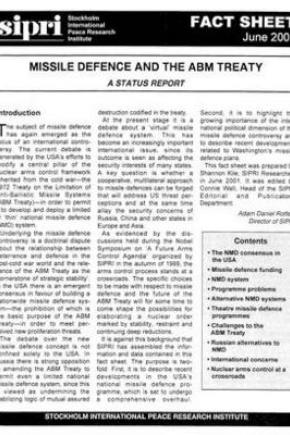Missile Defence and the ABM Treaty: A Status Report
The subject of missile defence has again emerged as the focus of an international controversy. The current debate is generated by the USA's efforts to modify a central pillar of the nuclear arms control framework inherited from the cold war—the 1972 Treaty on the Limitation of Anti-Ballistic Missile Systems (ABM Treaty)—in order to permit it to develop and deploy a limited or thin national missile defence (NMD) system.
Underlying the missile defence controversy is a doctrinal dispute about the relationship between deterrence and defence in the post-cold war world and the relevance of the ABM Treaty as the cornerstone of strategic stability. In the USA there is an emergent consensus in favour of building a nationwide missile defence system, the prohibition of which is the basic purpose of the ABM Treaty, in order to meet perceived new proliferation threats.
The debate over the new missile defence concept is not confined solely to the USA. In Russia there is strong opposition to amending the ABM Treaty to permit even a limited national missile defence system, since this is viewed as undermining the stabilizing logic of mutual assured destruction codified in the treaty. At the present stage it is a debate about a virtual missile defence system. This has become an increasingly important international issue, since its outcome is seen as affecting the security interests of many states. A key question is whether a cooperative, multilateral approach to missile defences can be forged that will address US threat perceptions and at the same time allay the security concerns of Russia, China and other states in Europe and Asia.
As evidenced by the discussions held during the Nobel Symposium on A Future Arms Control Agenda organized by SIPRI in the autumn of 1999, the arms control process stands at a crossroads. The specific choices to be made with respect to missile defence and the future of the ABM Treaty will for some time to come shape the possibilities for elaborating a nuclear order marked by stability, restraint and continuing deep reductions.
It is against this background that SIPRI has assembled the information and data contained in this fact sheet. The purpose is twofold. First, it is to describe recent developments in the USA's national missile defence programme, which is set to undergo a comprehensive overhaul. Second, it is to highlight the growing importance of the international political dimension of the missile defence controversy and to describe recent developments related to Washington's missile defence plans.
- The NMD consensus in the USA
- Missile defence funding
- NMD system
- Programme problems
- Alternative NMD systems
- Theatre missile defence programmes
- Challenges to the ABM Treaty
- Russian alternatives to strategic missile defence
- International concerns
- Nuclear arms control at a crossroads

